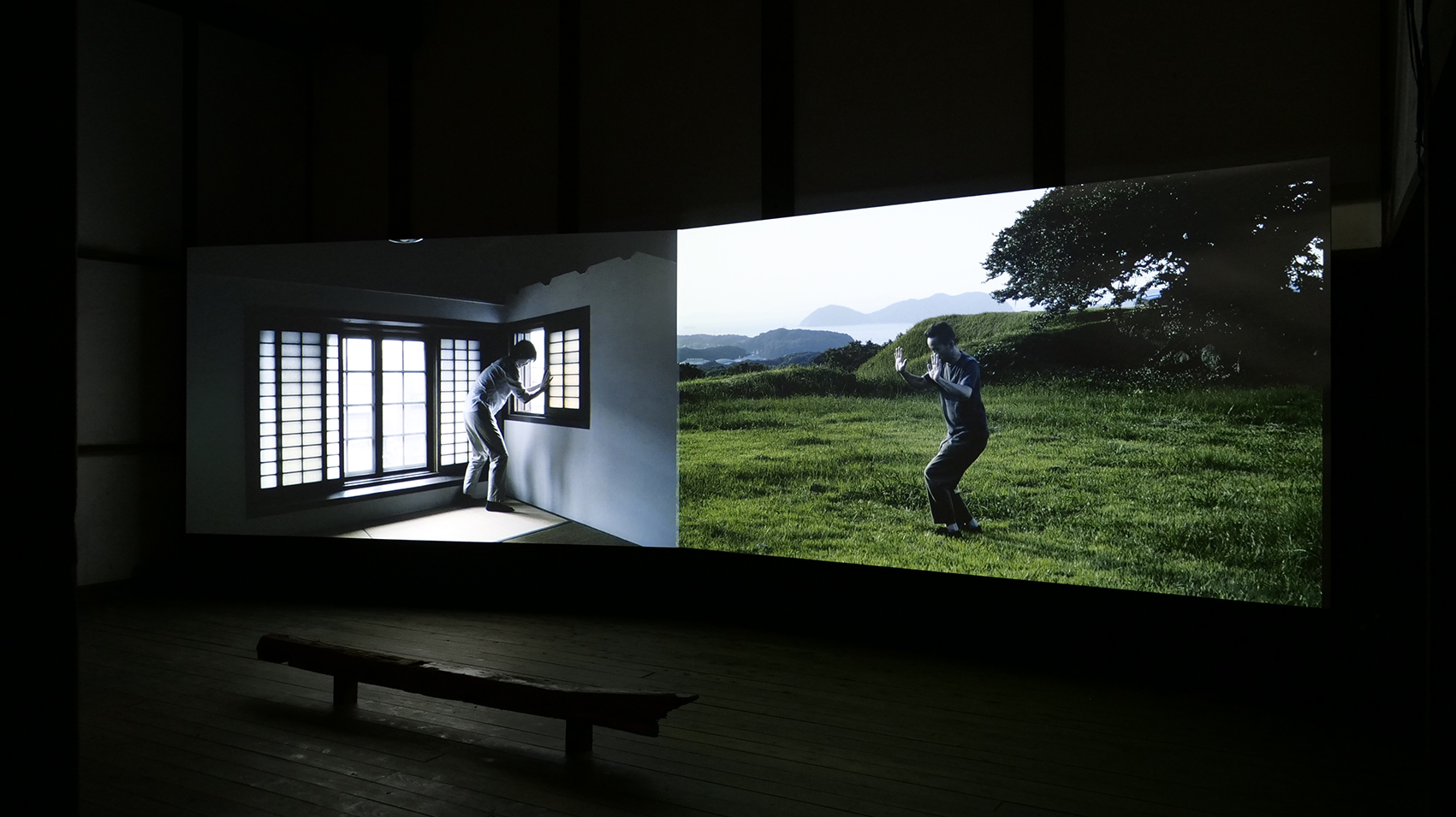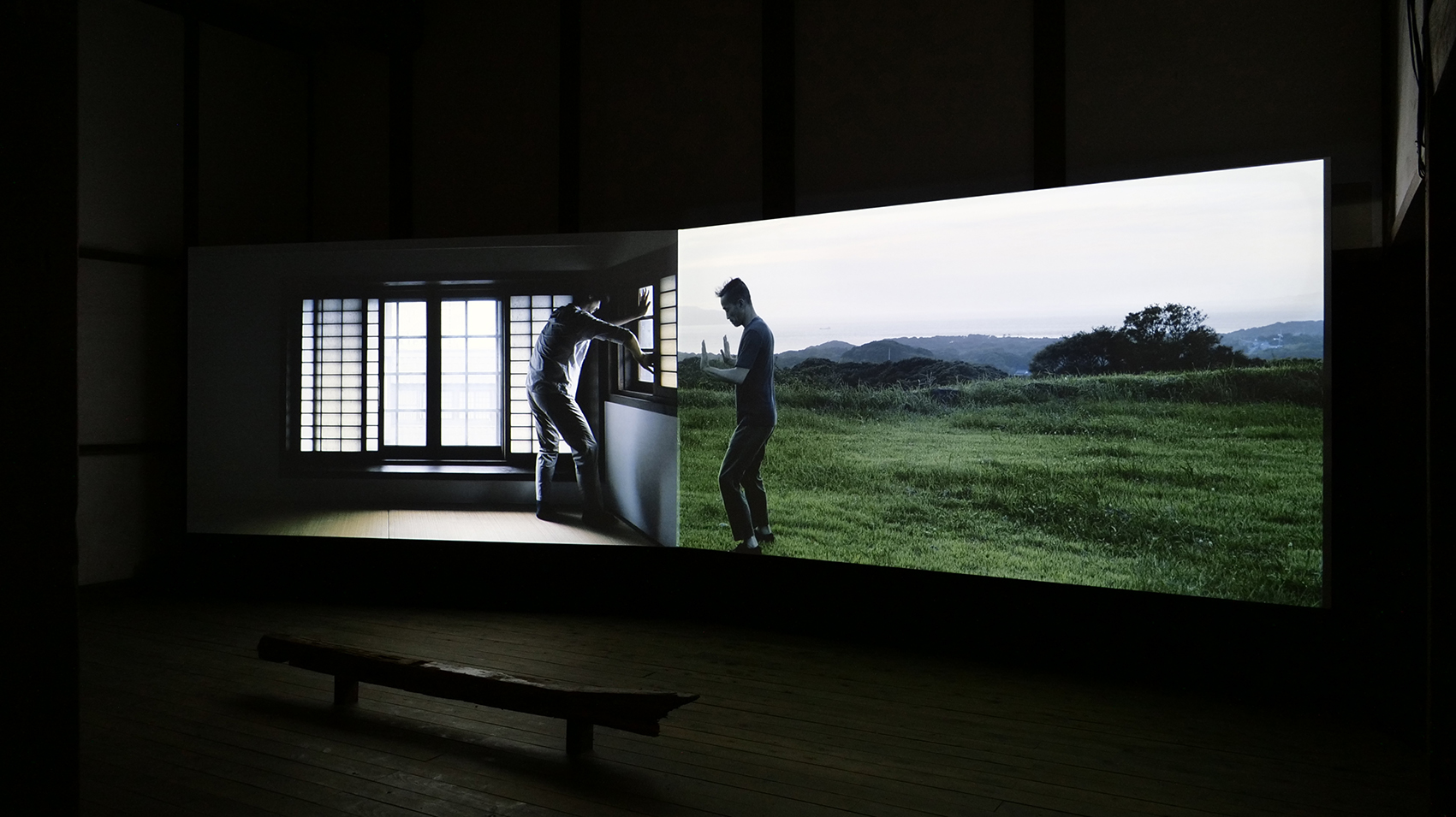

《もし彼らが生きていたら、今宵の月をどう見ただろうか》
2023 年、FHD、2チャンネルビデオ(8 分 12 秒)、 韓国仁川市の日本家屋の柱材、作家蔵
マイム:Ketch, Junghun Lee
サウンド:上村洋一
本作は、鎌田が2020年、福岡移住後すぐに「九州とアジア」をテーマに着手した、現在も継続して調査と制作を続けている
作品である。
1592 年、豊臣秀吉によって朝鮮半島を含むアジア大陸侵略のための軍事基地として築かれた肥前名護屋城(佐賀県)。 そこでは大陸侵略と同時に茶道や能などの桃山文化が花開いた。秀吉は「黄金の茶室」を用いて茶会を開催したとさ れているが、現在その地には石垣以外の痕跡は残っていない。
いっぽう韓国各地には、1910 年から 1945 年まで日本が朝鮮を植民地化して建設した様々な建築物が今も残ってい る。特に港湾都市仁川では、庶民住宅だった日本家屋のある風景を多く見ることができる。日常的に外を歩くたびに 見たくなくても植民地時代の痕跡を目にしてしまう。反対に日本では過去の帝国主義の痕跡を感じることは難しい。 その痕跡の多くが日本の外に残されているからだ。 本作で映される2つの画面では、右に名護屋城跡、左に仁川に現存している日本家屋の風景が映し出され、両国の パントマイムアーティストが、「現存する/現存しない」日本家屋に触れようと試みる。見えるものと見えないものを めぐり、私たちは現代において日韓の歴史の重層性をどのように引き受けることができるだろうか。 タイトルは、朝鮮の初代総督である寺内正毅が 1910 年の併合式典の際に、秀吉の朝鮮出兵に参加した諸将の名前 を引用して詠んだ「小早川、加藤、小西がこの世にいたら、今夜の月をどう見ただろうか」という歌を批判的に引用 している。
“If they were alive, how would they look the moon of tonight”
2023, FHD, 2-channel video (8 min. 12 sec.)
wood columns of a Japanese house in Incheon, Korea, artist’s collection
Mime:Ketch, Junghun Lee
Sound:Yoichi Kamimura
This work is an ongoing research and production project that Kamata embarked on immediately after moving to Fukuoka under the theme of “Kyushu and Asia.
Hizen Nagoya Castle (Saga Prefecture) was built by Toyotomi Hideyoshi in 1592 as a military base for his invasion of the Asian continent, including the Korean peninsula. There, Momoyama culture, including tea ceremony and Noh, flourished simultaneously with the invasion of the continent. It is said that Hideyoshi held tea ceremonies in his “golden tea house,” but today there are no traces of the castle other than its stone walls.
On the other hand, various buildings constructed by the Japanese during their colonization of Korea from 1910 to 1945 still remain in various parts of Korea. In the port city of Incheon, in particular, one can see many Japanese houses that were once homes for ordinary people. Every time we walk outside on a daily basis, we see traces of the colonial period even if we do not want to see them. In Japan, on the contrary, it is difficult to feel the traces of past imperialism. This is because many of these traces remain outside of Japan.
In this film, two screens show the ruins of Nagoya Castle on the right and the scenery of existing Japanese houses in Incheon on the left, and mime artists from both countries attempt to touch the “existing/non-existing” Japanese houses. How can we take on the multilayered nature of Japanese and Korean history in our time, over the visible and the invisible?
The title critically alludes to the poem “How would Kobayakawa, Kato, and Konishi have seen the moon tonight if they were still in this world?” that Masatake Terauchi, the first governor of Korea, composed on the occasion of the annexation ceremony in 1910, quoting the names of the generals who participated in Hideyoshi’s invasion of Korea.